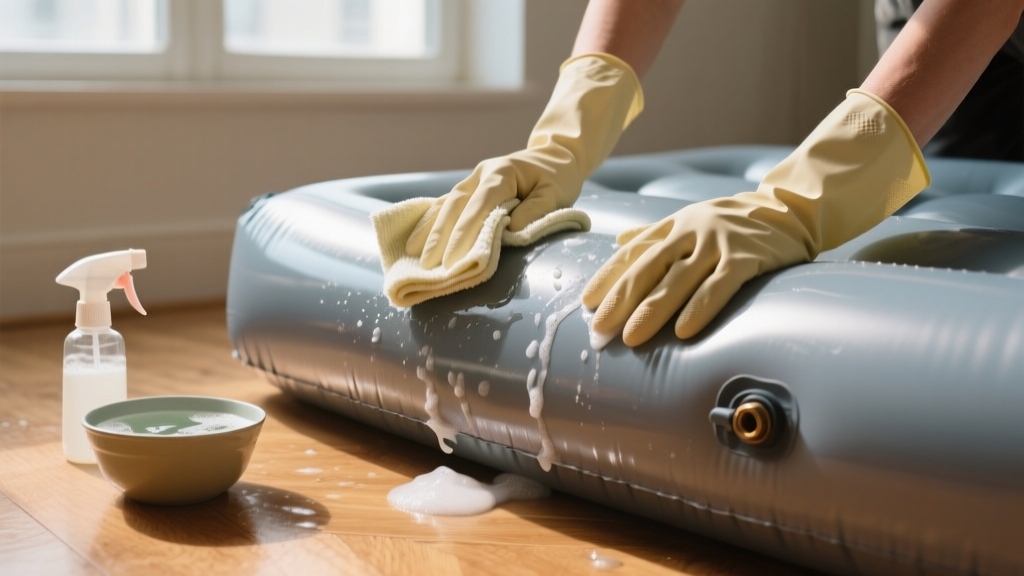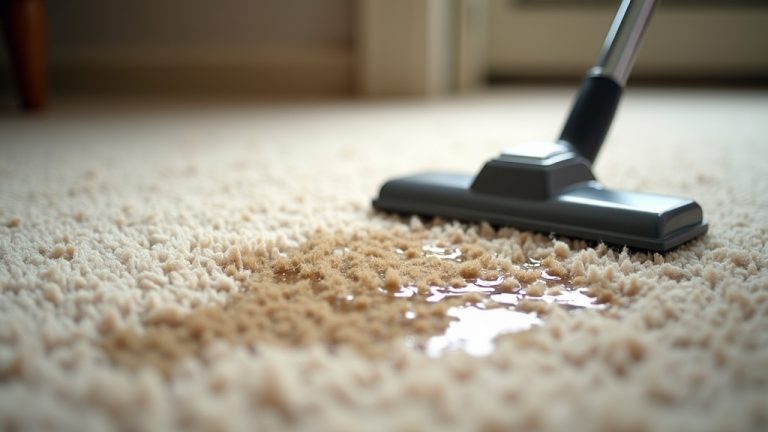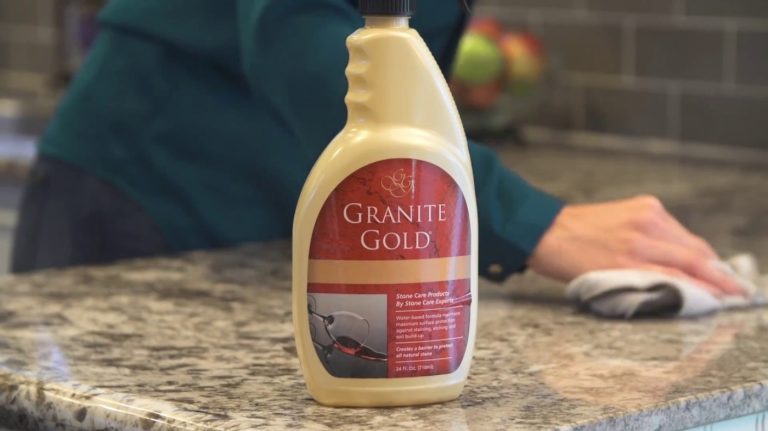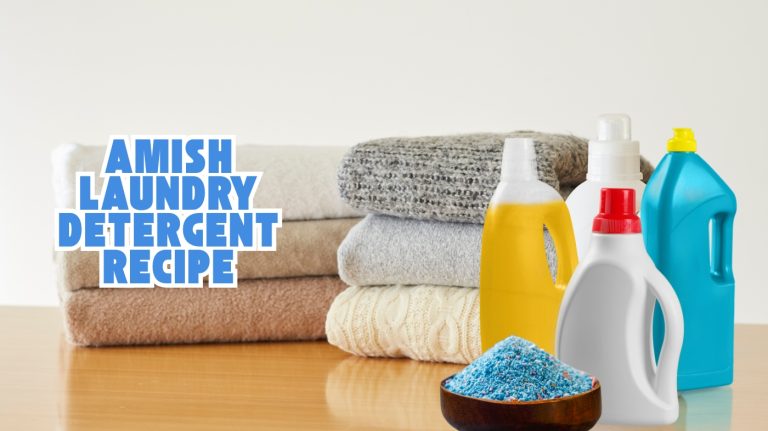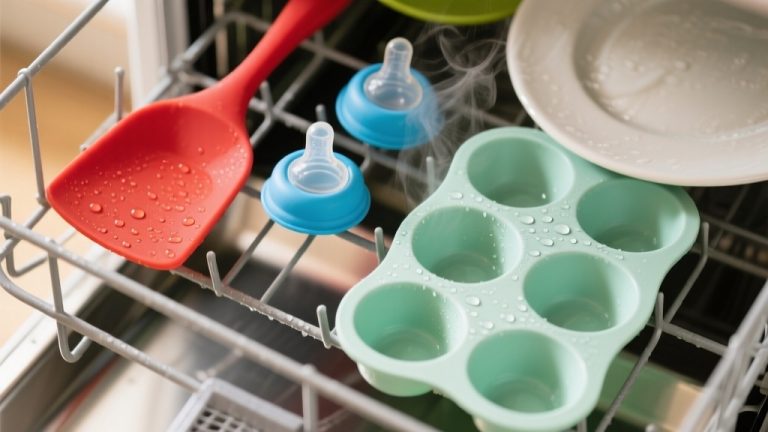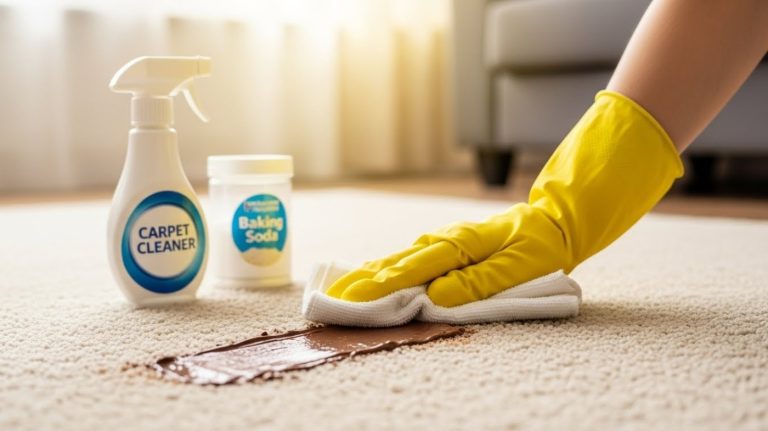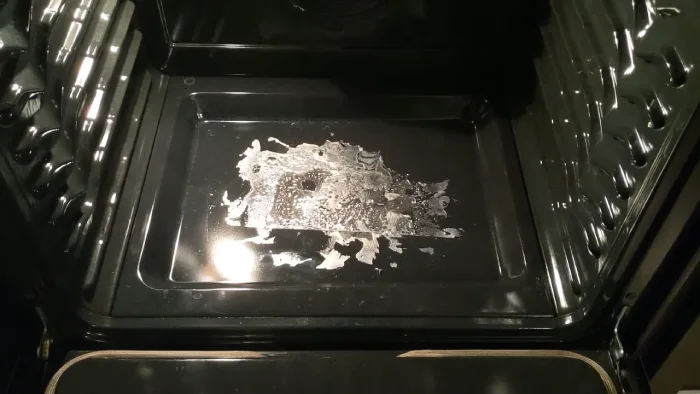How to Clean Airbed: Keep Your Bed Fresh Longer and Safer
To clean your airbed, first fully deflate it and vacuum with a soft brush to remove dust and debris. Spot-clean stains using mild detergent or a baking soda paste, avoiding soaking. Treat mold or mildew with a vinegar-water solution, then rinse lightly.
Dry thoroughly in a well-ventilated area to prevent moisture buildup. Use baking soda to neutralize odors before storing your airbed in a cool, dry place. Following these steps ensures a fresh, lasting mattress, and there’s more you can do to keep it in top shape.
Key Takeaways
- Fully deflate and lay the airbed flat before cleaning to expose all surfaces and seams.
- Vacuum with a soft brush attachment to remove dust, dirt, and pet hair from all areas.
- Gently clean stains using mild detergent, baking soda paste, or vinegar-water solution, avoiding soaking the material.
- Rinse with a damp cloth, air dry thoroughly in a ventilated, shaded area to prevent mold growth.
- Store completely dry in a cool, dry place using ventilated bags to avoid moisture and mildew buildup.
Preparing Your Airbed for Cleaning
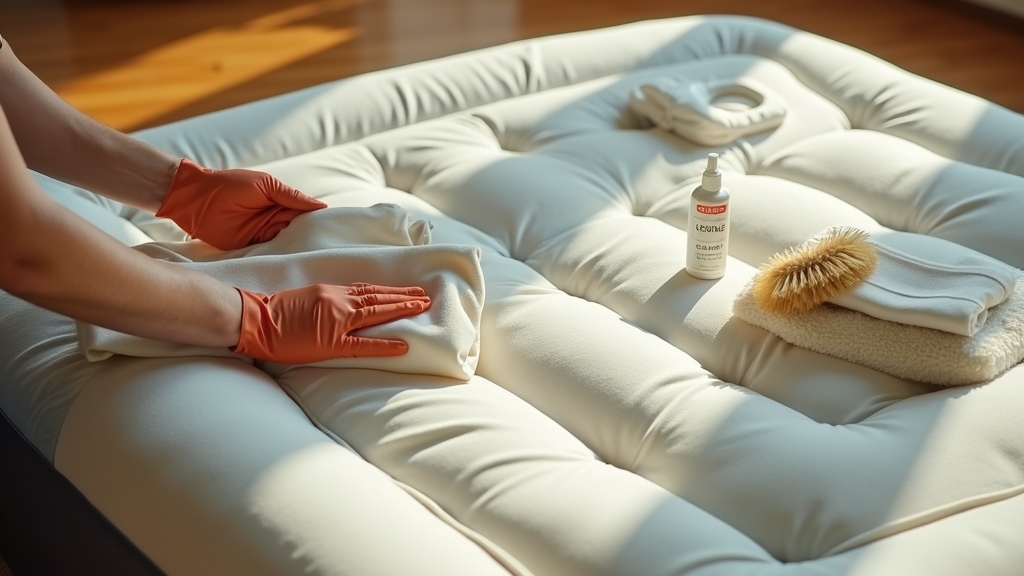
Before cleaning your airbed, ensure it is fully deflated and remove any attached power cords or pump connections to prevent damage and gain full access to the surface.
Lay the mattress flat and taut to expose all areas, so you can easily spot stains, mold, or damage. Using appropriate cleaning tools will help maintain the material’s integrity during the process.
Detach and launder any sheets, covers, or protectors separately in hot, soapy water. As you deflate, avoid sharp objects or folding too tightly to preserve the material’s integrity. Next, inspect the mattress closely for leaks, mold, or heavy stains that might need special treatment.
Check seams and valves for damage and ensure the cleaning space is well-ventilated to help with drying later. Regular inspection for leaks and damage helps prevent deterioration and maintain cleanliness.
This preparation sets you up for an effective, safe cleaning process.
Removing Dust and Debris
To get started, grab your vacuum cleaner and attach the upholstery nozzle. This will help you gently lift away dust and debris from the surface of your airbed. Using tools with microfiber pads can enhance dust removal without damaging delicate materials.
Make sure to pay extra attention to the seams and crevices, as that’s where dirt and pet hair tend to hide. Just take your time and use slow, careful strokes; this way, you won’t risk damaging the material.
Regular cleaning maintains comfort and hygiene for guests and helps prevent difficulty in cleaning due to accumulated dirt over time thorough cleaning post-use.
Keeping your airbed clean is essential for maintaining that velour plush feel, plus it helps prevent any buildup that could impact your comfort and hygiene. So, make it a routine to give it a good vacuuming!
Vacuuming Techniques
When you fully inflate your airbed, you expose all surfaces evenly and smooth out wrinkles, making vacuuming more effective. Use a vacuum with an upholstery or soft brush attachment to protect the airbed’s surface.
Avoid vacuuming when the mattress is deflated, as creases trap dust. Follow these steps for thorough cleaning:
- Slowly run the vacuum over the entire top surface, applying gentle pressure to avoid damage.
- Extend vacuuming to creases and seams where debris collects.
- Flip the mattress and vacuum the bottom to remove hidden dirt.
- For heavily soiled spots, perform multiple passes to dislodge trapped dust.
Using tools with soft natural bristles can help gently remove stubborn particles without damaging the material. After vacuuming, air dry the mattress completely to prevent mold growth. Regular vacuuming prevents particle buildup and extends your airbed’s lifespan.
Handling Delicate Surfaces
Vacuuming your airbed removes most loose dust and debris, but handling its delicate surfaces requires extra care to avoid damage. Start by inflating the airbed slightly to smooth wrinkles, making dust removal easier.
Use a handheld vacuum or an upholstery attachment to gently lift dust, pet hair, and dirt without scratching. Selecting the right cleaning tools ensures the surface remains intact and undamaged.
Avoid vigorous rubbing or abrasive brushes that can damage the vinyl or fabric. When wiping, choose a soft cloth or sponge wrung out well to minimize moisture contact. Always test cleaning solutions on a hidden spot first.
Mild detergent mixed with warm water or a diluted white vinegar solution works well for gentle cleaning. It is important to avoid soaking the mattress during cleaning to prevent internal moisture seeping inside.
Regularly vacuuming and wiping down your airbed this way helps maintain its surface integrity and prolongs its lifespan.
Cleaning Surface Dirt and Stains
Hey there! To clean your airbed, start by grabbing a soft cloth and dipping it in a mild detergent solution. You’ll want to use gentle circular motions to lift off the surface dirt without risking any damage to the material. Using a soft-bristled brush can also help reach crevices without scratching the surface.
If you come across any stubborn stains, don’t worry! Just whip up a baking soda paste and apply it to the stain. Use a soft brush to scrub lightly, and then rinse the area with a damp cloth to remove any soap residue. Address stains promptly to prevent damage and odor buildup.
Once you’re done cleaning, make sure to pat the surface dry. It’s a good idea to air it out thoroughly afterward to prevent any moisture buildup and keep mold at bay. Proper drying and ventilation are key to avoiding moisture buildup issues. Happy cleaning!
Mild Detergent Usage
Although airbeds are designed for durability, they still attract surface dirt and light stains that require gentle cleaning. Using a mild detergent solution is your best bet to keep the surface intact while removing grime effectively.
Here’s how to do it:
- Mix a few drops of mild detergent with warm water, testing on a small spot first.
- Apply the solution with a soft cloth or sponge, scrubbing gently in circular motions.
- Wipe the entire airbed, including seams and sides, but avoid soaking the material. This helps prevent the buildup of dust and dirt that can cause allergens and discomfort. It is important to also ensure proper ventilation during cleaning to avoid moisture-related issues.
- Rinse with a damp cloth to remove soap residue, then pat dry and air dry completely out of direct sunlight.
This method maintains your airbed’s waterproof coating and prevents damage or mold buildup. Regular maintenance is key to reducing fire risks associated with unattended moisture or electrical appliances nearby.
Stain Removal Techniques
Keeping your airbed clean goes beyond regular washing with mild detergent. You’ll want to tackle stains as soon as they appear to prevent them from setting in.
Start by blotting fresh stains gently with a clean cloth to avoid spreading or embedding the stain. For blood stains, use cold water first, then apply a diluted hydrogen peroxide solution. Incorporating enzyme-rich treatments can enhance the breakdown of organic stains and maintain material integrity.
Mold and mildew respond well to a vinegar-water spray followed by gentle scrubbing with a soft brush. It is important to dry the airbed completely after cleaning to prevent mold growth, especially if drying conditions are not ideal.
Ink stains require dabbing with rubbing alcohol, blotting immediately. For stubborn surface stains, apply a baking soda paste, leave it for 1–2 hours, then brush off lightly. Always test your cleaning agent on a hidden patch first, avoid soaking the airbed, and use gentle motions to protect the material.
Rinsing and Drying
How should you rinse and dry your airbed to guarantee it stays clean without causing damage? Start by wiping the mattress with a clean cloth dampened in lukewarm water to remove soap residue, avoiding soaking or direct running water.
Avoid over-wetting to prevent mould and mildew. Proper airflow is essential during drying to prevent moisture accumulation that can lead to damage. Focus gently on seams and crevices to prevent material stress.
Then, air dry thoroughly in a shaded, well-ventilated area to avoid mold and UV damage. If outdoor drying isn’t possible, place it near a dehumidifier or in a warm, dry room with good airflow.
Follow these steps:
- Use a soft cloth or sponge with plain lukewarm water for rinsing.
- Repeat wiping until detergent is fully removed.
- Dry completely on all sides, including seams.
- Store in a clean, dry place after drying to maintain moisture control and prevent deterioration.
Tackling Mold and Mildew
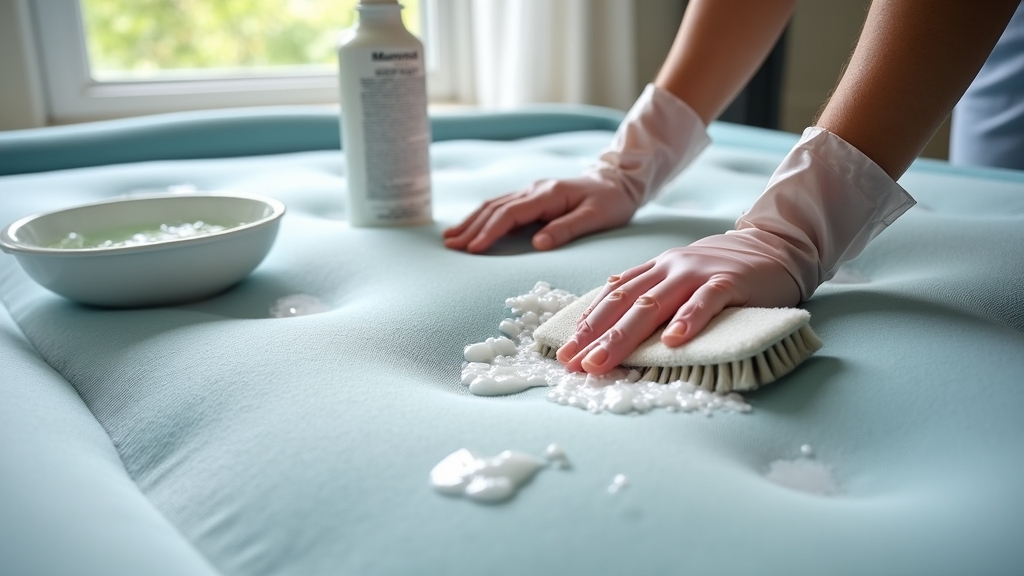
When you notice mold or mildew on your airbed, act quickly to prevent damage and health risks.
Start by applying a mixture of equal parts white vinegar and water with a sponge, then rinse and air dry. Using UV sterilization can further help eliminate mold spores and dust mites from the surface.
Apply equal parts white vinegar and water with a sponge, then rinse and air dry to clean your airbed.
For mildew, use isopropyl alcohol diluted with warm water, clean gently, rinse thoroughly, and let it dry completely. You can also scrub stubborn spots with a lemon juice and salt paste to leverage natural acidity.
Avoid harsh chemicals or abrasive tools that might harm the mattress material. After cleaning, dry the airbed outside in indirect sunlight or near a dehumidifier indoors to remove moisture fully, as proper drying prevents mold growth.
Make sure it’s completely dry before storing, ideally in a dry, ventilated area to prevent mold from returning.
Eliminating Odors From Your Airbed
Although airbeds provide convenient comfort, they can develop unpleasant odors over time that affect your sleeping experience. To eliminate these odors effectively, follow these steps:
- Sprinkle baking soda evenly over the airbed and let it sit for several hours or overnight to absorb odors. Then vacuum thoroughly.
- Mix equal parts white vinegar and water in a spray bottle, mist the airbed surface, and wipe gently to neutralize odor-causing bacteria. Rinse with water afterward.
- Use commercial odor eliminators or disinfectants for persistent smells, focusing on previously soiled areas, and follow product instructions carefully.
- Air out your airbed in a well-ventilated space or outdoors to allow volatile compounds to evaporate naturally, helping maintain freshness.
Proper Drying Techniques
After removing odors from your airbed, drying it properly prevents moisture from causing mold or mildew. Start by inflating the airbed fully to avoid moisture trapping in folds.
Place it in a well-ventilated area; outdoor sunlight is best for quick drying, but avoid direct sun on velour surfaces to prevent damage. Proper ventilation and airflow significantly speed up the drying process.
If drying indoors, open windows or use fans to boost airflow. Promoting good air circulation helps prevent mold growth. Pat the surface with absorbent cloths to remove excess water before air drying.
Use a vacuum upholstery attachment to extract moisture from seams. Employ a dehumidifier nearby if humidity is high. Flip or rotate the airbed periodically for even drying.
Avoid high heat sources like hair dryers to prevent warping. Make sure the airbed is completely dry before storing to prevent mold and odors.
Storing Your Airbed Safely
To keep your airbed in top condition, you’ll need to store it properly by choosing the right bag and location.
Start by fully deflating and cleaning your airbed, ensuring it’s dry to prevent mold. It is also important to clean the exterior of any pumps you plan to store to maintain their functionality cleaning pumps.
Use the original or a vacuum-sealed bag that allows ventilation and protects against pests and punctures. Store your airbed in a cool, dry place away from direct sunlight, avoiding temperature extremes and high humidity.
Keep it off the floor on a soft surface to prevent damage. Follow these steps:
- Roll gently instead of folding to avoid creases.
- Remove and store pumps and accessories separately.
- Label storage bags for quick identification.
- Ensure the storage area is well-ventilated and pest-free.
Routine Maintenance Tips for Longevity
When you maintain your airbed regularly, you’ll extend its lifespan and keep it performing well. Focus on storing it in a cool, dry place away from extreme temperatures. Roll or fold it gently following the manufacturer’s instructions to avoid stress points.
Air the mattress periodically during storage to keep the material flexible and prevent cracks. Avoid harsh cleaners and mechanical strain during cleaning to protect its structure. Always keep repair supplies and a suitable pump handy for quick fixes.
| Maintenance Task | Key Tip |
|---|---|
| Storage | Cool, dry place, avoid humidity |
| Folding | Gentle roll/fold per instructions |
| Airing | Periodic airing to maintain flexibility |
| Cleaning | Use mild agents, avoid harsh chemicals |
| Repair Preparation | Keep patch kit and pump accessible |
Frequently Asked Questions
Can I Use Bleach to Clean My Airbed Safely?
You shouldn’t use bleach to clean your airbed. Bleach’s harsh chemicals can weaken materials, cause discoloration, and even lead to leaks or punctures. Instead, use mild detergent mixed with water or a vinegar solution for safe cleaning.
Always spot clean and avoid soaking your airbed. After cleaning, rinse with a damp cloth and let it air dry thoroughly to keep your airbed in good shape and avoid damage or health risks.
How Often Should I Deep Clean My Airbed?
You should deep clean your airbed at least once a year to keep it fresh and hygienic. If you use it daily or for camping, clean it every 3 to 4 months. Increase cleaning if it’s exposed to sweat, spills, or outdoor dirt.
Always inspect for stains, odors, or mold before use and clean immediately if you spot any. Following these steps helps extend your airbed’s lifespan and maintain a healthy sleeping surface.
Is It Okay to Use a Steam Cleaner on an Airbed?
Yes, you can use a steam cleaner on your airbed, but you need to be careful. Choose a steam cleaner with adjustable temperature, ideally for upholstery. Vacuum the airbed first, then do short, overlapping steam passes without lingering too long to avoid damage.
Always test a small area first. After steaming, deflate and dry the airbed thoroughly to prevent mold or mildew from trapped moisture.
Can Airbeds Be Machine Washed or Put in a Dryer?
No, you shouldn’t machine wash or put your airbed in a dryer. The agitation and water can damage its surface and seams, causing leaks or deformities. Dryers’ heat and tumbling can melt or warp the materials, ruining your mattress.
Instead, spot clean with mild detergent, blot moisture, and air dry in a cool, shaded area. This keeps your airbed safe and extends its lifespan.
What Should I Do if My Airbed Develops a Tear During Cleaning?
If your airbed tears during cleaning, first fully deflate it to prevent worsening the damage. Locate and mark the tear, then clean the area thoroughly with isopropyl alcohol.
Cut a vinyl patch slightly larger than the tear. Apply adhesive thinly to both surfaces, and press the patch firmly, removing air bubbles. Secure with a heavy object and let it cure for 8-12 hours before inflating to test for leaks.
Discover the Best Odor Removers and Mold Treatments for Airbeds
So, now that you’ve mastered the art of pampering your airbed, don’t just toss it in a dark closet to sulk. Treat it like the royalty it is—clean, dry, and stored properly.
Ignore these steps, and your airbed might rebel with mold, odors, or an epic flat-out strike. Keep it fresh, keep it happy, and it’ll keep you comfy. Remember, your airbed isn’t just plastic—it’s your inflatable throne!

